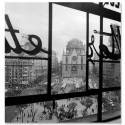
The year was 1934. The Second World War had not yet commenced, but the Nazi regime had. Similarly to many Jewish people at the time, the family of Alice Brill (1920-2013) also fled their home country to escape the horror of a dictatorial regime that would make up one of the most dramatic episodes of the twentieth century. In 1933, Hitler (in his madness), took over Germany, causing the break-out of important avant-garde artists, such as the intellectuals of the Frankfurt School and Bauhaus. Many of these artists and photographers came to Brazil during those years, among them Hildegard Rosenthal (1913-1990) and Hans Gunter Flieg (1923), whose avant-guard view collaborated to modernize Brazilian photography.
But Alice Brill was still a 14-year-old adolescent when she arrived in Brazil. She travelled in the company of her father to meet her mother, who had arrived in Brazil first. Among her belongings was a small camera with which she photographed the landscapes during the long trip to an unknown country where there were no persecutions. Daughter of a painter, who could not bear homesickness and returned to his hometown to die in a concentration camp in 1942, Alice followed her father’s vocation. She became a painter, an engraving artist, and mainly a photographer. In the 40s she became a member of the infamous São Paulo art group Santa Hele, and six years later she was granted a scholarship and moved to New Mexico, United States, where she developed her artistic skills.
Once she returned to Brazil she dedicated herself mainly to photography. She photographed the process of modernization of São Paulo, participated in the first Biennale of São Paulo and worked as an art critic, publishing most of her articles in the Estado de São Paulo Newspaper.
Alice Brill died in Itu, in 2013. Three years before she confined the guardianship of her 14 thousand negatives to the Moreira Salles Institute. Five years ago, the IMS had the initiative to organise a retrospective exhibit of her work, focusing on the diversity of her photography. A new perspective of her work is being organized by the art curator Giovanna Bragaglia, who gathered 90 photographs in addition to images of the artist that appeared on the press, in the show: Alice Brill: Impressões ao Rés do Chão.
Speaking of the humanist perspective of the exhibit is almost a pleonasm. Alice uses her photography to understand and appropriate herself of the cities she depicts. These are photographs of cities of Latin America, made in the 50s and 60s. Some images of São Paulo were commissioned by Pietro Maria Bardi, former director of Masp, for a book published to celebrate the 400th anniversary of the city. (THE BOOK WAS PUBLISHED). The exhibit also brings photographs of the centre-west region of Brazil. Maybe one should not see Alice’s work as a foreigner’s outlook on Brazil. Undoubtedly her photographic depictions of the cities are not only passionately patriotic, but also critical chronicles of places whose process of modernization results in people’s discontentment with a non-organized development. With her camera Alice Brill made urban chronicles of the cities and places she visited.

Deixe um comentário